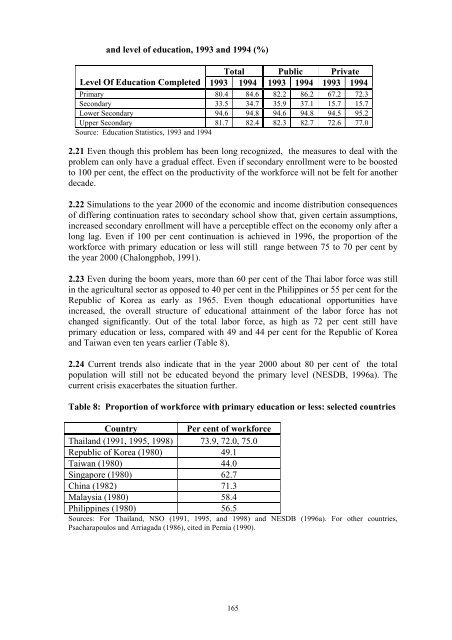Educational Finance in Thailand - UNESCO Bangkok
Educational Finance in Thailand - UNESCO Bangkok
Educational Finance in Thailand - UNESCO Bangkok
Create successful ePaper yourself
Turn your PDF publications into a flip-book with our unique Google optimized e-Paper software.
and level of education, 1993 and 1994 (%)<br />
Total Public Private<br />
Level Of Education Completed 1993 1994 1993 1994 1993 1994<br />
Primary 80.4 84.6 82.2 86.2 67.2 72.3<br />
Secondary 33.5 34.7 35.9 37.1 15.7 15.7<br />
Lower Secondary 94.6 94.8 94.6 94.8 94.5 95.2<br />
Upper Secondary 81.7 82.4 82.3 82.7 72.6 77.0<br />
Source: Education Statistics, 1993 and 1994<br />
2.21 Even though this problem has been long recognized, the measures to deal with the<br />
problem can only have a gradual effect. Even if secondary enrollment were to be boosted<br />
to 100 per cent, the effect on the productivity of the workforce will not be felt for another<br />
decade.<br />
2.22 Simulations to the year 2000 of the economic and <strong>in</strong>come distribution consequences<br />
of differ<strong>in</strong>g cont<strong>in</strong>uation rates to secondary school show that, given certa<strong>in</strong> assumptions,<br />
<strong>in</strong>creased secondary enrollment will have a perceptible effect on the economy only after a<br />
long lag. Even if 100 per cent cont<strong>in</strong>uation is achieved <strong>in</strong> 1996, the proportion of the<br />
workforce with primary education or less will still range between 75 to 70 per cent by<br />
the year 2000 (Chalongphob, 1991).<br />
2.23 Even dur<strong>in</strong>g the boom years, more than 60 per cent of the Thai labor force was still<br />
<strong>in</strong> the agricultural sector as opposed to 40 per cent <strong>in</strong> the Philipp<strong>in</strong>es or 55 per cent for the<br />
Republic of Korea as early as 1965. Even though educational opportunities have<br />
<strong>in</strong>creased, the overall structure of educational atta<strong>in</strong>ment of the labor force has not<br />
changed significantly. Out of the total labor force, as high as 72 per cent still have<br />
primary education or less, compared with 49 and 44 per cent for the Republic of Korea<br />
and Taiwan even ten years earlier (Table 8).<br />
2.24 Current trends also <strong>in</strong>dicate that <strong>in</strong> the year 2000 about 80 per cent of the total<br />
population will still not be educated beyond the primary level (NESDB, 1996a). The<br />
current crisis exacerbates the situation further.<br />
Table 8: Proportion of workforce with primary education or less: selected countries<br />
Country<br />
Per cent of workforce<br />
<strong>Thailand</strong> (1991, 1995, 1998) 73.9, 72.0, 75.0<br />
Republic of Korea (1980) 49.1<br />
Taiwan (1980) 44.0<br />
S<strong>in</strong>gapore (1980) 62.7<br />
Ch<strong>in</strong>a (1982) 71.3<br />
Malaysia (1980) 58.4<br />
Philipp<strong>in</strong>es (1980) 56.5<br />
Sources: For <strong>Thailand</strong>, NSO (1991, 1995, and 1998) and NESDB (1996a). For other countries,<br />
Psacharapoulos and Arriagada (1986), cited <strong>in</strong> Pernia (1990).<br />
165

















